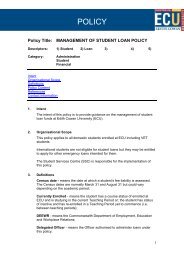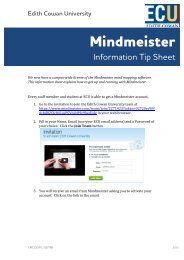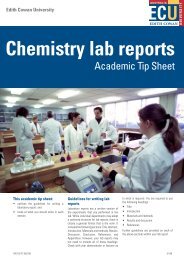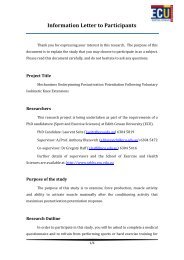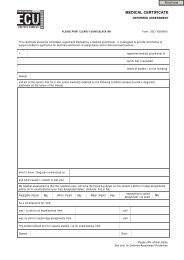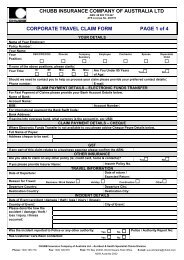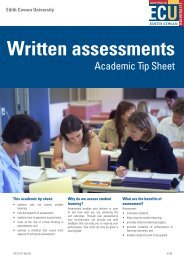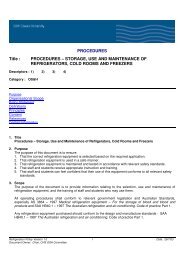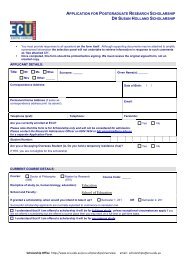Benchmarking: A Literature Review - ECU | Sign In : Portals - Edith ...
Benchmarking: A Literature Review - ECU | Sign In : Portals - Edith ...
Benchmarking: A Literature Review - ECU | Sign In : Portals - Edith ...
You also want an ePaper? Increase the reach of your titles
YUMPU automatically turns print PDFs into web optimized ePapers that Google loves.
A project by the Australian Universities Quality Agency (AUQA) 1 developed a list of success factors for highereducation benchmarking:1. Determine which areas to benchmark;2. Identify benchmarking partners;3. Determine types and level of benchmarking;4. Prepare benchmarking documents and templates including the purpose, scope of project,performance indicators, performance measures and performance data;5. Design benchmarking process;6. Implement benchmarking process;7. <strong>Review</strong> results;8. Communicate results and recommendations; and,9. Implement improvement strategies,with questions for each step (Booth, Melano, Sainsbury, & Woodley, 2011). This aligns with the Plan/ Do/<strong>Review</strong>/ Improve (PDRI) cycle in the Quality@<strong>ECU</strong> model, and it is the suggested method for benchmarkingat <strong>ECU</strong> (see Table 1 for details).1 AUQA has since been replaced by the Tertiary Education Quality & Standards Agency (TEQSA).2<strong>Benchmarking</strong>: A <strong>Literature</strong> <strong>Review</strong>
What is <strong>Benchmarking</strong>?<strong>ECU</strong> defines benchmarking as a continuous and systematic process of comparing products, services,processes and outcomes with other organisations or exemplars, for the purpose of improving outcomes byidentifying, adapting and implementing best practice approaches (<strong>Edith</strong> Cowan University, 2011).<strong>Benchmarking</strong> enables universities to assess their performance and improve practice in a cyclical processinvolving both quality assurance and quality enhancement (Oliver, 2011b). When learning of yet anotherquality management tool, administrators often respond that they have been doing benchmarking for yearsbut not calling it that (Epper, 1999). <strong>Benchmarking</strong> is different to using quality assurance (QA) models asthey generally focus on minimum acceptable standards and compliance, and are often imposed bymanagement or external inspection requirements (Henderson-Smart, et al., 2006) that may have a politicalagenda (Houston, 2008). <strong>Benchmarking</strong> may provide a conceptual framework for self-evaluation(Henderson-Smart, et al., 2006).<strong>Benchmarking</strong> is a well-planned and systematic process with clear objectives and mechanisms to measure,compare and discover innovative practices, evaluate if these suit or adapt practices, and implementimprovement. <strong>Benchmarking</strong> provides a formal exchange of information within an objective structure andtimeline (Meade, 1998) and focuses on learning (Wilson & Pitman, 2000; Wilson, et al., 2000). Comparisonsmay be made against individual benchmarking partners or groups; other programs within the University; setsof accepted standards; or data from past performance (Learning and Teaching Unit, 2012).<strong>Benchmarking</strong> is a tool for improving performance. Learning and teaching are thought to be a challengingarea to benchmark because it is difficult to quantify the outcomes and performance in learning and teaching(Oliver, 2011b). <strong>In</strong> this area, benchmarking is an evidence-based process including comparisons with otherinstitutions in order to enhance good practice (Learning and Teaching Unit, 2012).The kind of benchmarking or knowledge-sharing that typically takes place in higher education in Australia ismostly the result of friendly rivalry between respected peers or peer organisations that resemble our own(Epper, 1999). <strong>In</strong> contrast to this model, “true” benchmarking encourages an organisation to look beyondpeers to quite different benchmarking partners encouraging ‘outside-the-box’ thinking as distinguished from“simply sharing knowledge with one’s peers”. <strong>Benchmarking</strong> provides a model for action, not just data. Itdistinguishes between real innovation and simple reputation. A lot of learning takes place (Epper, 1999).<strong>Benchmarking</strong> is a tool to assist organisations identify processes they need to change to be able to achievespecific strategic goals and objectives (Hacker & Kleiner, 2000). <strong>Benchmarking</strong> is the formal and structuredprocess of searching for those practices which lead to excellent performance, the observation and exchangeof information about those practices, the adoption of those practices to meet the needs of one’s ownorganisation, and their implementation (Meade, 1998). <strong>Benchmarking</strong> is focused on improvement so itcomplements other improvement initiatives; the terms best practice, quality improvement and quality cycleare commonly used interchangeably.Principles of <strong>Benchmarking</strong>Ten principles form benchmarking theory (Meade, 1998). <strong>Benchmarking</strong>:1. Improves practices, services or products;2. <strong>In</strong>volves learning about ‘best practices’ from others;3. Accelerates the rate of progress and improvements;4. Contributes to continuous quality management;5. Is an ongoing process;3<strong>Benchmarking</strong>: A <strong>Literature</strong> <strong>Review</strong>
6. Promotes fresh and innovative thinking about problems;7. Provides hard data on performance;8. Focuses not only on what is achieved, but on how it is achieved;9. <strong>In</strong>volves the adaptation, not merely adoption, of best practices; and,10. Results in the setting of specific targets.(Meade, 1998)Why Benchmark? – BenefitsWhy should higher education organisations care about benchmarking? <strong>In</strong> a word: competition (Epper, 1999).<strong>In</strong> the past, it may have been possible to identify friendly rivals but recently the competitive landscape ischanging quickly with new, non-traditional rivals that may be overlooked as competitors or benchmarkingpartners (Epper, 1999).One of the most important benefits of benchmarking is the discovery of innovative approaches.<strong>Benchmarking</strong> highlights problem areas and the potential for improvement, providing an incentive tochange, and assists in setting targets and formulating plans and strategies (Meade, 1998). <strong>Benchmarking</strong>provides assessments of quality that identify measures that give a valid and balanced, current picture of theparameters that distinguish courses, universities or sections of a university (McKinnon, et al., 2000).As a result of good benchmarking, university leaders would know how their institution rates in certain areasin comparison with others, ascertain their competitive position relative to others, and also know how theirinstitution can be improved (McKinnon, et al., 2000). <strong>Benchmarking</strong> may enable an institution to lay alegitimate claim to being “distinguished” in a particular area (Dunn, McCarthy, Baker, Halonen, & Hill, 2007).The findings from benchmarking enable universities to prioritise resources and use their resources to besteffect (McKinnon, et al., 2000). <strong>Benchmarking</strong> can ensure that plans are being carried out and demonstrateareas of merit to stakeholders (Wilson & Pitman, 2000). Yet benchmarking distinguishes between realinnovation and simple reputation as it focuses on demonstrating best practices beyond their initial launch(Epper, 1999).To maximise the benefits of benchmarking, institutions must undergo a thorough self-analysis and have aclear understanding of their own processes (Epper, 1999) which may be more useful than the comparisonwith another organisation. Beyond the potentially humbling learning experience of benchmarking, thenetworking creates opportunities for further collaboration (Epper, 1999).Criticisms of <strong>Benchmarking</strong><strong>In</strong> order to be successful and to ensure positive outcomes for all partners, benchmarking must beapproached with some insight into the potential pitfalls and problems that may arise (Wilson, et al., 2000).For instance, benchmarking can be expensive and the scope must be narrow to make the study manageable(Epper, 1999). Potential challenges include the need to ensure agreed outcomes for all partners;participative training and awareness for all staff involved; and the need for benchmarking to sit within abroader framework of quality management and improvement (Wilson, et al., 2000).By focusing on processes and practices that are already occurring and only on another institution’s bestpractice, Hammer and Champy (1993, cited in Meade, 1998) argue that benchmarking may restrictinnovation and ambition. Similarly, they state, by focusing on current processes and practices the need toprepare for a changing future and adapt to new conditions may not be fulfilled. Epper (1999) distinguishesthis as “simply sharing knowledge with one’s peers” and not “true” benchmarking.4<strong>Benchmarking</strong>: A <strong>Literature</strong> <strong>Review</strong>
If an organisation is to benchmark themselves against better and best organisations inside or outside theeducation sector as Meade (2000) and Epper (1999) suggest, then it may be difficult to choose the partnerorganisation. It may be impossible to know which potential partner organisation is the best in any specificarea until data has been gathered and comparisons made. University league tables may purport to showrankings of excellence and self-identified sub-groups of universities may directly or indirectly claim merit byassociation. <strong>In</strong>dividual universities may market their university or a specialist area as the best (McKinnon, etal., 2000). They may only be the best in a small area so several partners may be required. Similarly, it isimpossible to find a partner that is better if your organisation is the best in that specific area. Ifbenchmarking is a way of learning from others (Epper, 1999), then the question becomes why anorganisation that knows it is the best in a specified area would commit the time and effort required to abenchmarking process.Data may not be comparable between different institutions or even sections within the same institutionbecause of different reporting conventions, different instruments used, and distrust amongst universities(McKinnon, et al., 2000) making results unreliable.What is the Difference between <strong>Benchmarking</strong> and Moderation?Frequently, the terms benchmarking and moderation are used interchangeably in conversation. Yet they arequite different; for example, to benchmark an institution’s student grades, marks and assessments is not thesame as moderating these. Moderation as a process involves the checking of assessment marking to ensurereliability, validity, fairness and accuracy (Bloxham, 2009) whenever more than one person marksassessment items in a unit (<strong>Edith</strong> Cowan University, 2012). The same coded unit may be offered in differentsemesters, schools, campuses or even in different countries. Moderation of assessments checks thatmarking is consistent such that an assessment item would be awarded the same mark by any marker.Whereas, the aim of benchmarking assessment processes is to make transparent the areas for improvementand areas of good practice. The <strong>ECU</strong> policy on Moderation of Assessment (<strong>Edith</strong> Cowan University, 2012)clarifies the process.Types of <strong>Benchmarking</strong>There are many types of benchmarking and many ways of categorizing these types. Some terms are used bydifferent authors with different meanings. Each type seems useful for a particular situation. However, thetype of benchmarking is not as important as that the aims are clear, achievable and achieved, and that thechoice of partner organisation is aligned with the aims. Epper (1999) speaks of “true” benchmarking incontrast to “sharing knowledge with one’s peers”.Three types of benchmarking advocated by the Australian Universities Quality Agency (AUQA) are:1. Sector benchmarking in which comparisons of ‘whole-of-institution’ or focusing on some function oraspect are made against a benchmarking partner(s) in the same sector;2. Generic benchmarking involving comparisons of processes and practices regardless of the industry;and,3. Best practice benchmarking in which the University selects a comparator known to be best in thearea to be benchmarked.(Stella & Woodhouse, 2007)Terms for types of benchmarking may be used with several meanings. For example, Griffith Universitydistinguishes sector from whole-of-institution benchmarking. Sector benchmarking is a comparison of otheruniversity’s performance outcomes using publicly available data or of processes and practices within thesector in selected areas with a view to identifying areas for improvement (Griffith University, 2012).5<strong>Benchmarking</strong>: A <strong>Literature</strong> <strong>Review</strong>
Standards-based benchmarking analyses processes, practices and outcomes against a generally agreed set ofstandards, e.g. those set by professional bodies for accreditation (Griffith University, 2012). Two types ofstandards-based benchmarking are clearly distinguished (McKinnon, et al., 2000):1. Criterion reference benchmarking first defines the attributes of good practice in a functional area,then assesses whether that criteria has been achieved. The definition could be a checklist ofessential attributes constituting good practice. If the benchmarking process concludes that theuniversity is meeting the criterion then the university is meeting that benchmark. If thebenchmarking process concludes that the university is not meeting the criterion, then there is clarityabout what needs improvement.2. Quantitative benchmarking distinguishes normative and competitive levels of achievement,demonstrating where practice is quantifiably different in some institutions. Differences may signalpriorities, choice and policy rather than a need for improvement, e.g. proportion of postgraduatestudents within total enrolment.There are four types of benchmarking based on the kind of organisation serving as the benchmarkingpartner (Meade, 1998):1. <strong>In</strong>ternal benchmarking in which comparisons are made against another division within theorganisation;2. Competitive benchmarking in which comparisons are made against direct competitors;3. <strong>In</strong>dustry benchmarking in which the benchmarking partner is not a direct competitor but does sharethe same industry; and,4. Generic benchmarking compares processes and practices regardless of the industry.Process benchmarking is by far the most commonly used model (Wilson & Pitman, 2000) of three types ofbenchmarking based on the practices or processes being benchmarked (Meade, 1998):1. Process benchmarking focuses on discrete work processes and operating practices;2. Performance benchmarking compares products and services; and,3. Strategic benchmarking examines how companies compete.<strong>Benchmarking</strong> MethodsNumerous models of benchmarking are discussed in the literature (Meade, 1998). However, the approachesare fundamentally similar and can be adapted for specific circumstances, fitting the University’s qualitymodel or policy framework (Hacker & Kleiner, 2000; Meade, 1998). The <strong>ECU</strong> approach to continuousimprovement, the Quality@<strong>ECU</strong> model, is cyclic with four phases: Plan; Do; <strong>Review</strong>; and Improve (<strong>Edith</strong>Cowan University, 2010). Alongside the Quality@<strong>ECU</strong> model, the nine-step method of success factors forhigher education benchmarking (Booth, et al., 2011) has specific questions as guidance (see Table 1).Comparisons may be made against individual benchmarking partners or groups; other programs within theUniversity; sets of accepted standards; or data from past performance (Learning and Teaching Unit, 2012). Athree step process for benchmarking involves:1. Identifying areas for improvement;2. Choosing benchmark indicators (quantitative measures of achievement); and then,3. Collecting information to enable comparisons in order to improve performance.(Learning and Teaching Unit, 2012)6<strong>Benchmarking</strong>: A <strong>Literature</strong> <strong>Review</strong>
A twelve-step benchmarking process has four phases: planning; analysis; integration; and action (Hacker &Kleiner, 2000).1. Planning has five steps: determine what to benchmark, identify key performance indicators, identifybenchmarking partners, determine data collection method, and collect data;2. Analysis has two steps: understand performance gaps, and predict future performance levels;3. <strong>In</strong>tegration has two steps: communicate findings and gain acceptance, then establish functionalgoals and implementation plans; and,4. Action has three steps: implement and monitor progress, measure results against stakeholder wantsand needs, and then recalibrate benchmarks.Amin and Amin (2003) used a student self-assessment tool, pre- and post-tests to measure studentcompetencies, and an external test to benchmark curriculum. McKinnon et al. (2000) provide lists of goodpractice definitions and description of levels for ten aspects of universities including organisational climate.Three major steps in the benchmarking process are:1. Self-evaluation against the benchmarks;2. Comparing and contrasting self-evaluations against the benchmarks with benchmarking partners;and,3. Applying benchmarking outcomes to improvement processes.(Council of Australian Directors of Academic Development, 2011)An AUQA project developed a list of success factors for higher education benchmarking:1. Determine which areas to benchmark;2. Identify benchmarking partners;3. Determine types and level of benchmarking;4. Prepare benchmarking documents and templates including the purpose, scope of project,performance indicators, performance measures and performance data;5. Design benchmarking process;6. Implement benchmarking process;7. <strong>Review</strong> results;8. Communicate results and recommendations; and,9. Implement improvement strategies,with questions for each step (Booth, et al., 2011). This model aligns with the Quality@<strong>ECU</strong> model so it is thesuggested method for benchmarking at <strong>ECU</strong> (see Table 1 for details).<strong>Benchmarking</strong> Courses and Assessment<strong>Benchmarking</strong> is most effective when it is ongoing, not a one-off procedure, but part of the annual reviewprocess (The Association of Commonwealth Universities, 2012b). <strong>Benchmarking</strong> leads to continuouscurriculum improvement (Amin & Amin, 2003) in response to the nascent trend of concern with questions ofeducational quality (Dunn, et al., 2007). Statistics from the public domain released annually by theDepartment of Education, Employment and Workplace Relations (DEEWR, now the Department of<strong>In</strong>novation, <strong>In</strong>dustry, Science, Research and Tertiary Education [DIISRTE]) is used to benchmark a number ofmeasures of universities’ international student programs using data from OECD countries (Olsen, 2011).Outgoing student mobility was benchmarked to quantify international study experiences in 2010 of studentsat Australian universities (Olsen, 2011).The benchmarking process at a course level should be collaborative rather than competitive and aims toengage course teaching teams in critical conversations about improving capability achievement particularlyfor employability (Oliver, 2011a, 2011b). Eight broad educational dimensions provide the framework for7<strong>Benchmarking</strong>: A <strong>Literature</strong> <strong>Review</strong>
enchmarking undergraduate courses: curriculum, assessment issues, student learning outcomes, programresources, student development, faculty characteristics, program climate, and administrative support (Dunn,et al., 2007).The <strong>Benchmarking</strong> Portfolio (Oliver, 2011b) is a 360-degree, evidence-based approach with four phases:1. Determine capabilities: determine the capabilities that count for early professional success;2. Map inputs: when, where and how those capabilities are developed and assessed in the course asdemonstrated by reflective (qualitative) and numerical (quantitative) evidence;3. Evaluate outcomes: engage with partners (internal and external stakeholders); and,4. Plan enhancements.Many institutions use a template for reporting that reflects the priorities and values (Dunn, et al., 2007).Alignment between curriculum, teaching and assessment as the conceptual framework for self-evaluation ispivotal (Henderson-Smart, et al., 2006), while content, instruction, assessment and equity and diversity wereconsidered as curriculum (Ellibee & Mason, 1997).The Australasian Council on Open, Distance and e-Learning (ACODE) provide a benchmarking plan withscoping statements, good practice statements, and performance indicators and measures for eight areas:1. <strong>In</strong>stitution policy and governance for technology supported learning and teaching;2. Planning for and quality improvement of the integration of technologies for learning and teaching;3. <strong>In</strong>formation technology infrastructure to support learning and teaching;4. Pedagogical application of information and communication technology;5. Professional/staff development for effective use of technologies for learning and teaching;6. Staff support for the use of technologies for learning and teaching;7. Student training for the effective use of technologies for learning; and,8. Student support for the use of technologies for learning.(Australasian Council on Open Distance and e-Learning, 2007)Examples of <strong>Benchmarking</strong> of Courses1. The speech pathology discipline in Australia and New Zealand identified a valid framework of studentlearning outcomes, threshold standards and effective strategies to benchmark against these standards thatresulted in the development of a valid and reliable competency-based assessment tool called COMPASS ®(McAllister et al., 2011). Competencies and level of achievement required of graduate speech pathologistsare the seven Speech Pathology Competency-Based Occupational Standards – Entry Level (referred to asCBOS). Reasoning, Lifelong Learning, Communication and Professionalism were also identified by theprofession as important professional capacities (McAllister, et al., 2011).2. Communications discipline course leaders from three universities benchmarked their journalismundergraduate courses starting with a review of literature identifying streams of literature over the pastfifteen years (Oliver, Bethell, Fernanadez, Harrison, & Breit, 2011).3. A benchmarking project on archaeology courses in Australian universities paid attention to criteriadeveloped to assess students’ demonstrated understanding and skills, and the teaching and learningenvironment (Teaching and Learning Centre, 2008).4. A project to benchmark assessment between three Australian universities was carefully scoped through acollaborative process checking that it was achievable and within the timeframe. The project resulted in aclear, robust framework for benchmarking assessment (Booth, et al., 2011). Statements of good practice inassessment were developed as one part of a Teaching Quality <strong>In</strong>dicators ALTC project (Davies, 2009). Theformat was derived from the ACODE <strong>Benchmarking</strong> Framework (Australasian Council on Open Distance ande-Learning, 2007). All three universities used self-reviews to facilitate discussion and reflection as well as tocollect and evaluate data. Yet each university adopted different methodologies for the self-review (Booth, etal., 2011).8<strong>Benchmarking</strong>: A <strong>Literature</strong> <strong>Review</strong>
<strong>Benchmarking</strong> the Whole-of-UniversityThe ACU University Management <strong>Benchmarking</strong> Programme, active since 1996, is used primarily, but notexclusively, for universities from the Commonwealth. It focuses on the effectiveness of university-wideprocesses and policies, offering a unique and cost-effective opportunity for participating universities tocompare their key management processes with those in a range of other universities. This helps to identifyareas for change and assists in setting targets for improvement and identifying techniques for managingchange. It enables members to learn from each others' experience of difficulty and success, acrossinternational boundaries (The Association of Commonwealth Universities, 2012a).<strong>Benchmarking</strong> University’s Service CentresMuch benchmarking of <strong>ECU</strong> service centres is conducted routinely and frequently under the auspices ofnational and state external bodies. For example, <strong>ECU</strong>’s Finance and Business Services Centre has partneredwith Australian universities to benchmark procurement activities, processes, systems and staff capabilities.<strong>Benchmarking</strong> university libraries is common practice throughout Australia (Wilson & Pitman, 2000; Wilson,et al., 2000). The CAUL Performance <strong>In</strong>dicator database enables comparisons of outcomes and encouragesthe sharing of good practices that led to these outcomes (Council of Australian University Librarians, 2012).The approach to benchmarking academic development units (ADU) (e.g. <strong>ECU</strong>’s Centre for Learning andDevelopment) advocated by the Council of Australian Directors of Academic Development (CADAD) is basedon collaborative peer assessment of performance in each of eight domains and sub-domains consideredrelevant to the particular ADU against performance indicators (Council of Australian Directors of AcademicDevelopment, 2011). The eight domains are: strategy, policy and governance; quality of learning andteaching; scholarship of learning and teaching; professional development; credit-bearing programs in highereducation; curriculum development; engagement with the university’s communities; and ADU effectiveness(Council of Australian Directors of Academic Development, 2011).The Universities’ HR <strong>Benchmarking</strong> Program commenced in 2004 and has attracted 38 Australian universitiesand 10 international universities (Australian Higher Education <strong>In</strong>dustrial Association, 2012). A selfassessmenttool for HR benchmarking in Australian universities has questions in a framework for recruitmentand selection; performance management and development; and workforce composition and planning (<strong>Edith</strong>Cowan University, 2007).Australian University <strong>In</strong>ternational Directors’ Forum (AUIDF) has conducted benchmarking studies annuallysince 2002 with all 38 members of Universities Australia involved in 2010 (Olsen, 2011). Universities areinvited to participate in benchmarking ten aspects of international offices including: costs; staffing;admissions policies and procedures; student services; student mobility; recruitment costs; conversion rates(applications-offers-commencements); organisational structures; scholarships; and, accommodation.One final example of benchmarking conducted in <strong>ECU</strong>’s service centres is the Graduate Research School’sbenchmarking exercise with all Australian universities, looking at areas including: completion rates; years tocompletion; enrolment status over time-period; completion rates by broad field of education (FOE); and,course level movement. The final report on this benchmarking project was presented at the national Councilof Deans and Directors of Graduate Studies in Australia (DDOGS) meeting in 2010, with support from allAustralian universities to continue with the benchmarking exercise in 2011.9<strong>Benchmarking</strong>: A <strong>Literature</strong> <strong>Review</strong>
Table 1: Success Factors for Higher Education <strong>Benchmarking</strong>(Booth, et al., 2011)1. Determine which areas to benchmarki. Is this area aligned to strategic goals in priority areas?ii. Will a major project in this area deliver significant benefits relative to the costs?iii. Are there drivers in this area which will sustain energy for the process, and ensure thatbenchmarking is given priority?iv. Is benchmarking in this area supported at the executive level and on the ground?v. Are there adequate human, financial and other resources to support benchmarking in this area?YESContinueNORethink2. Identify benchmarking partnersi. If possible, is there a history of sharing practice and/or an established relationship to build upon?ii. Do the partners have compatible institutional missions, values and goals?iii. Is there a comparable commitment to benchmarking in this area from senior and other relevantmanagers of the partner institutions?iv. Is there a high level of trust between senior and other relevant managers of the partnerinstitutions?v. Is there a shared understanding of explicit benchmarking goals?vi. Are all partners willing to share information and discuss successes and failures?vii. Are the partners similar enough to offer transferable strategies in this area?YESContinueNORethink3. Determine types and level of benchmarkingi. Is there broad agreement on the types of benchmarking, e.g. data-sharing, strategy-sharing,evidence-based self-review?ii. Is there broad agreement on the level of benchmarking (e.g. policy level, discipline level, courselevel, unit level)?iii. Is there agreement on the model that should be the basis for benchmarking? If no existing modelcan be used or adapted, are there sufficient resources to develop and test a suitable new model?iv. Is there agreement on what is and what is not to be in scope?v. Is the scope realistic and achievable by the participants within the anticipated timeframe?YESDevelop and sign MOU and continueNORethink4. Prepare benchmarking documents and templates including the purpose, scope of project, performanceindicators, performance measures and performance datai. Have the indicators and measures been clearly documented and thoroughly reviewed by eachuniversity for alignment to local structures, processes and terminology?ii.iii.YESContinueAre the indicators and measures aligned to accepted standards and good practice across the sector?Have participants who will be carrying out the benchmarking, e.g. Faculty and/or professionalleaders, had the opportunity to provide feedback to ensure clarity and fit?NOFurther development needed10<strong>Benchmarking</strong>: A <strong>Literature</strong> <strong>Review</strong>
5. Design benchmarking processi. Is there a benchmarking reference/steering group?ii. Have Faculty and/or professional leaders had the opportunity to comment and contribute to thedesign of the process?iii. Does the benchmarking process encourage:• Engagement?• Sharing, both within and across areas?• Reflection?• An evidence-based approach?• Identification of good practice?• Identification of areas for improvement?iv. Does the choice of process align with organisational culture – for example, does it mirror otherforms of scholarly collaboration (e.g. round-tables, academic committees, surveys, comments onpapers)?v. Does the process minimise demands on staff time?YESContinueNOFurther development needed6. Implement benchmarking processi. Is there a communication plan?ii. Have Faculty and/or professional leaders been briefed on their responsibilities?iii. Is there appropriate project management?iv. Are there clear expectations for deliverables and deadlines?v. Is there a checking process (quality assurance)?YESContinueNOFurther development needed7. <strong>Review</strong> resultsi. Have Faculty and/or professional leaders had the opportunity to contribute to the review process?ii. Does the review process encourage engagement, reflection and sharing, both within and acrossinstitutions?iii. Is the review process designed to produce a clear evaluation, including ratings, identification ofgood practice and identification of areas for improvement?iv. Is the review process carried out at multiple levels, e.g. faculty level, institutional level, acrossinstitutions?YESContinueNOFurther development needed8. Communicate results and recommendationsi. Do reports clearly identify good practice, standard practice and recommendations for improvementfor each university?ii. Within each university, is there a consultation process to obtain agreement on recommendations,e.g. through management and committee structures?iii.iv.YESContinueWere participants acknowledged and thanked?Is there a process for sharing the benchmarking methodology and lessons learned with other areasof the university?NOFurther development needed11<strong>Benchmarking</strong>: A <strong>Literature</strong> <strong>Review</strong>
9. Implement improvement strategiesi. Are there clearly assigned responsibilities for implementing the recommended improvements?ii. Have future collaborations between the universities been agreed, where this would assistimprovements?iii. Is there a process for monitoring and reporting on the implementation of recommendedimprovements and their effectiveness?YESContinueNOFurther development needed12<strong>Benchmarking</strong>: A <strong>Literature</strong> <strong>Review</strong>
ReferencesAmin, M. R., & Amin, N. A. (2003). <strong>Benchmarking</strong> learning outcomes of undergraduate business education.<strong>Benchmarking</strong>: An <strong>In</strong>ternational Journal, 10(6), 538-558. doi: 10.1108/14635770310505175Australasian Council on Open Distance and e-Learning. (2007). ACODE benchmarks for e-learning inuniversities and guidelines for use. Retrieved fromhttp://www.acode.edu.au/resources/acodebmguideline0607.pdf.Australian Higher Education <strong>In</strong>dustrial Association. (2012). The universities HR benchmarking program, fromhttp://www.hrd.qut.edu.au/hrbenchmarking/Bloxham, S. (2009). Marking and moderation in the UK: False assumptions and wasted resources.Assessment and Evaluation in Higher Education, 34(2), 209-220. doi: 10.1080/02602930801955978Booth, S., Melano, A., Sainsbury, H., & Woodley, L. (2011). Articulating and comparing standards throughbenchmarking of assessment. Paper presented at the Australian Universities Quality Forum:Demonstrating quality, Melbourne, VIC, Australia.Council of Australian Directors of Academic Development. (2011). <strong>Benchmarking</strong> performance of academicdevelopment units in Australian universities. Canberra, Australia: CADAD.Council of Australian University Librarians. (2012). Quality and assessment, fromhttp://www.caul.edu.au/caul-programs/best-practiceDavies, L. (2009). Assessment reform and quality context: Tensions and synergies. Paper presented at theAustralian Universities Quality Forum: <strong>In</strong>ternal and external quality assurance: tensions andsynergies, Alice Springs, Australia.Dunn, D. S., McCarthy, M. A., Baker, S., Halonen, J. S., & Hill, G. W. (2007). Quality benchmarks inundergraduate psychology programs. American Psychologist, 62(7), 650-670. doi: 10.1037/0003-066X.62.7.650<strong>Edith</strong> Cowan University. (2007). Self-assessment tool for HR benchmarking: Guidelines for conducting selfassessment.Retrieved fromhttp://www.hr.ecu.edu.au/shr/resource/Self_assessment_tool_benchmarking.pdf<strong>Edith</strong> Cowan University. (2010). Quality@<strong>ECU</strong> model. Retrieved fromhttp://intranet.ecu.edu.au/staff/centres/planning-quality-and-equity-services/our-services/qualityat-ecu<strong>Edith</strong> Cowan University. (2011). <strong>Benchmarking</strong> Policy. Retrieved fromhttp://www.ecu.edu.au/GPPS/policies_db/tmp/ad075.pdf<strong>Edith</strong> Cowan University. (2012). Moderation of Assessment. Retrieved fromhttp://www.ecu.edu.au/GPPS/policies_db/tmp/ac080.pdfEllibee, M. A., & Mason, S. A. (1997). <strong>Benchmarking</strong> for quality curriculum: The heart of school-to-work. NewDirections for Community Colleges, 97, 15-21.Epper, R. M. (1999). Applying benchmarking to higher education: Some lessons from experience. Change,31(6), 24-31.Griffith University. (2012). AUQA good practice database: Adopting a benchmarking-driven approach toquality assurance and improvement.Hacker, M. E., & Kleiner, B. M. (2000). 12 steps to better benchmarking. <strong>In</strong>dustrial Management, 42(2), 20-23.Henderson-Smart, C., Winning, T., Gerzina, T., King, S., & Hyde, S. (2006). <strong>Benchmarking</strong> learning andteaching: Developing a method. Quality Assurance in Education, 14(2), 143-155. doi:10.1108/09684880610662024Houston, D. (2008). Rethinking quality and improvement in higher education. Quality Assurance inEducation, 16(1), 61-79. doi: 10.1108/09684880810848413Learning and Teaching Unit. (2012). <strong>Benchmarking</strong>. Retrieved fromhttp://www.unisa.edu.au/academicdevelopment/quality/benchmark.asp13<strong>Benchmarking</strong>: A <strong>Literature</strong> <strong>Review</strong>
McAllister, S., Lincoln, M., Ferguson, A., Davidson, B., Hill, A., Davenport, R., et al. (2011). The benchmarkingCOMPASS® database: A confidential interactive web based strategy to benchmark learningoutcomes. Paper presented at the Australian Universities Quality Forum: Demonstrating quality,Melbourne, VIC, Australia.McKinnon, K. R., Walker, S. H., & Davis, D. (2000). <strong>Benchmarking</strong>: A manual for Australian universities.Canberra, Australia: Department of Education, Training and Youth Affairs, Higher Education Division.Meade, P. H. (1998). A guide to benchmarking. Dunedin, New Zealand: University of Otago.Oliver, B. (2011a). Assuring graduate capabilities: An approach to determining and evidencing standardsPaper presented at the Australian Universities Quality Forum: Demonstrating quality, Melbourne,VIC, Australia.Oliver, B. (2011b). Assuring graduate capabilities: Enhancing levels of achievement for graduate capability,from http://boliver.ning.com/page/benchmarking-2Oliver, B., Bethell, P., Fernanadez, J. M., Harrison, J., & Breit, R. (2011). <strong>Benchmarking</strong> journalism courseswith a focus on graduate employability: Case studies from three Australian universities. Paperpresented at the Australian Universities Quality Forum: Demonstrating quality, Melbourne, VIC,Australia.Olsen, A. (2011). 2011 research agenda: Australian universities international directors' forum. Paperpresented at the Australian <strong>In</strong>ternational Education Conference, fromhttp://cunningham.acer.edu.au/inted/AIEC2011AUIDFResearchPaper.pdfStella, A., & Woodhouse, D. (2007). <strong>Benchmarking</strong> in Australian higher education: A thematic analysis ofAUQA audit reports. Australian Universities Quality Agency. Retrieved fromhttp://pandora.nla.gov.au/pan/127066/20110826-0004/www.auqa.edu.au/files/publications/benchmarking_final_text_website.pdf.Teaching and Learning Centre. (2008). By degrees: <strong>Benchmarking</strong> archaeology degrees in Australianuniversities.The Association of Commonwealth Universities. (2012a). <strong>Benchmarking</strong> programme, fromhttp://www.acu.ac.uk/member_services/benchmarking_programme/benchmarking_programmeThe Association of Commonwealth Universities. (2012b). What is benchmarking?, fromhttp://www.acu.ac.uk/member_services/benchmarking_programme/what_is_benchmarkingWilson, A., & Pitman, L. (2000). Best practice handbook for Australian university libraries.Wilson, A., Pitman, L., & Trahn, I. (2000). Guidelines for the application of best practice in Australianuniversity libraries: <strong>In</strong>tranational and international benchmarks. Canberra: Department of Education,Training and Youth Affairs, Higher Education Division, Evaluations and <strong>In</strong>vestigations Programme.14<strong>Benchmarking</strong>: A <strong>Literature</strong> <strong>Review</strong>



